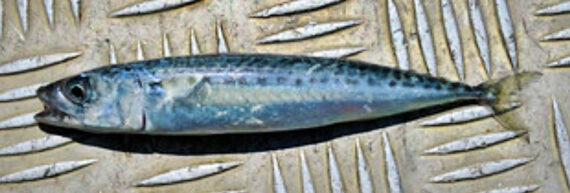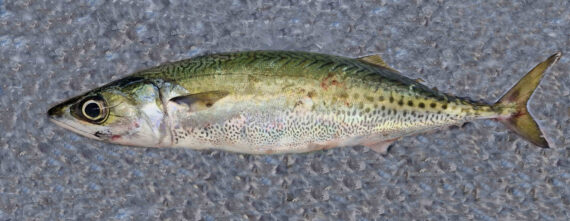Spotted Chub Mackerel, Scomber australasicus
 Spotted Chub Mackerel, Scomber australasicus. Fish caught from coastal waters off Sydney, Australia, September 2016. Length: 10 cm (3.9 inches). Catch, photograph and identification courtesy of Eli (obsessiveangling.wordpress.com).
Spotted Chub Mackerel, Scomber australasicus. Fish caught from coastal waters off Sydney, Australia, September 2016. Length: 10 cm (3.9 inches). Catch, photograph and identification courtesy of Eli (obsessiveangling.wordpress.com).
 Spotted Chub Mackerel, Scomber australasicus. Fish caught from a kayak in coastal waters off the Cabo San Lucas, Baja California Sur, January 2025. Length: 25.4 cm (10 inches). Catch and photography courtesy of Ricardo Rentina, Cabo San Lucas. Identification courtesy of Chip Shapley, Las Barilles, Baja California Sur.
Spotted Chub Mackerel, Scomber australasicus. Fish caught from a kayak in coastal waters off the Cabo San Lucas, Baja California Sur, January 2025. Length: 25.4 cm (10 inches). Catch and photography courtesy of Ricardo Rentina, Cabo San Lucas. Identification courtesy of Chip Shapley, Las Barilles, Baja California Sur.
 Spotted Chub Mackerel, Scomber australasicus. Fish caught from coastal waters off Wollongong, NSW, Australia, January 2020. Length: 30 cm (12 inches). Catch, photograph, and identification courtesy of Kenneth Tse, Toronto, Canada.
Spotted Chub Mackerel, Scomber australasicus. Fish caught from coastal waters off Wollongong, NSW, Australia, January 2020. Length: 30 cm (12 inches). Catch, photograph, and identification courtesy of Kenneth Tse, Toronto, Canada.
The Spotted Chub Mackerel, Scomber australasicus, is a member of the Mackerel or Scombridae Family, that is also known as the Blue Mackerel, the Japanese Mackerel, the Pacific Mackerel, the Slimy Mackerel, and the Spotted Mackerel and in Mexico as caballa pintoja and castilian. Globally, there are four species in the genus Scomber, of which three are found in Mexican waters, one in the Atlantic and two in the Pacific Ocean.
The Spotted Chub Mackerel has an elongated rounded fusiform tuna-like body that is designed aerodynamically for speed. They have a blue-gray upper body with numerous narrow, oblique, undulating, zigzag lines along the back and upper caudal base that transitions to a pearly white belly covered with undulating discontinuous wavy broken lines or spots. They have a pointed snout and large black eyes that are covered with adipose eyelids at the front and rear. The mouth has palatine teeth present on the roof.
with palatine teeth set in single and double rows. Their anal fin is small and originates behind the second dorsal fin and has 12 rays followed by 5 finlets; their caudal fin is deeply forked with 2 small keels on each side of the caudal peduncle; the first dorsal fin has 10 to 13 spines; the second dorsal fin is widely separated from the first and is small with 12 rays followed by 5 finlets; and, their pectoral fins are small and set high on the body. Their lateral line runs the entire length of the body. They are covered with small scales.
The Spotted Chub Mackerel is a pelagic oceanodromous species that can be found in open oceanic waters with sea surface temperature between 17oC (63oF) and 25oC (77oF) to depths up to 300 m (1,000 feet) and in coastal waters where they are found in large schools near inshore reefs. They are known to school by size and schools and form large compact structured schools of thousands of individuals and may also include Jack Mackerel, Trachurus symmetricus, and Pacific Sardine, Sardinops sagax. They reach a maximum of 47 cm (19 inches) in length and 2.1 kg (4 lbs 10 oz) in weight. As of January 1, 2024, the International Game Fish Association world record stood at 2.14 kg (4 lbs 11 oz) with the fish caught in coastal waters off the Hibiscus Coast of New Zealand in November 2011.
Spotted Chub Mackerel are diurnal plankton feeders, filtering copepods and other crustaceans, but adults are voracious and indiscriminate carnivores that consume anchovies and other smaller pelagic fish, krill also feed on pelagic invertebrates including ascidians, pyrosomes, and squids. In turn they are preyed upon by billfish, sharks, tunas, and other fish and marine mammals including dolphins and sea lions and various sea birds and rely heavily on camouflage for protection. Reproduction is oviparous with batch spawning occurring in several small batches with each female releasing between 22,000 and 70,000 eggs annually. Their eggs and larvae are pelagic. They have live spans of up to twenty-four years.
The Spotted Chub Mackerel has a large global residency being found in the Indo-West Pacific and the Tropical Eastern Pacific Ocean, the Red Sea and the western Arabian Sea. In Mexican waters they are known to inhabit the Revillagigedo and Socorro Islands and very rarely in the southern half of the Sea of Cortez.
The Spotted Chub Mackerel is easy to identify, however, it is virtually identical to the Atlantic Chub Mackerel, Scomber colias (which is found only in the Atlantic Ocean), and is very similar to the Pacific Chub Mackerel, Scomber japonicus (lacks spotting ventrally; 9 or 10 first dorsal spines).
From a conservation perspective the Spotted Chub Mackerel is currently considered to be of Least Concern with stable, very widely distributed populations. They are targeted commercially and harvested in purse seines at levels of 500,000 tons per annum. They are sold fresh, frozen, canned, and dried. They are consumed by humans smoked, grilled or broiled. They are utilized as meat binders added to meat products to keep the meat and seasoning bound tightly together lowering costs and enhancing flavor and texture of the product. They are also used in cat food. For recreational anglers they are a target species in some regions being caught on dead cut base and lures. They are also utilized as a live bait targeting tuna and other large game fish.